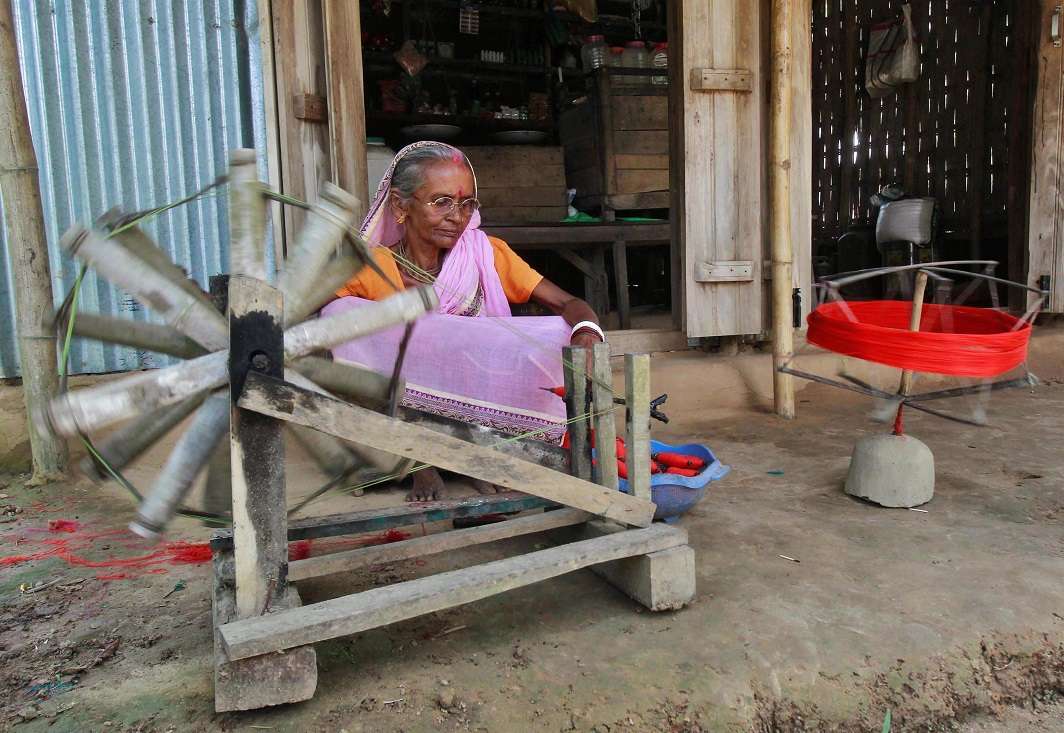The legal notice to Fabindia on violating the Khadi Mark could affect the fabric’s branding and marketing
~By Meha Mathur
Prominent clothing and accessories brand Fabindia finds itself at the center of a controversy which could damage its reputation. The Khadi and Village Industries Commission (KVIC), Government of India, which has been entrusted with the responsibility of promoting Khadi in the country, has sent a legal notice to it for selling its products under the “Khadi” label without obtaining the Khadi Mark certificate from KVIC. It was falsely selling its products under the “Khadi” tag. Following the notice issued by KVIC, Fabindia is removing the Khadi tag from products which claim “handspun, handwoven”. In its statements to media, it has stated that it will comply with the KVIC directions.
Interestingly, the fabric, that was originally a potent symbol of fight against British imperialism, has enjoyed its spot under the fashion arena with mainline fashion designers like Rohit Bal, Malini Ramani, David Abraham, Rakesh Thakore and Tarun Tahiliani giving it a bold and trendy avatar from time to time. The handspun and handwoven fabric has provided livelihood to millions of rural poor. Craft lover and politician Jaya Jaitley gave an identity to handspun, handwoven and handcrafted products through the Dastkari Samitis. In 2001, the then Union minister for small scale and agro industries Vasundhara Raje had unveiled a programme to revitalise Khadi bhandars all over the country to beat the stiff competition from rival brands. The KVIC, a statutory body formed in 1956, took over the All India Khadi and Village Industries Board that came into existence in April 1957, to oversee quality control.
KVIC Chairman Vinai Kumar Saxena says the question is of purity. Just as you have food safety regulations and food processing companies have to comply with FSSAI norms to ensure that there is no adulteration, and just as you have Woolmark to ensure purity, similarly the Khadi Mark is required if you sell Khadi. A long-enough window was provided to Fabindia to comply with, he says. KVIC sent Fabindia a letter in February 2016 stating the conditions it would have to comply to get the Khadi Mark tag. Till September 2016, several meetings were held and Fabindia assured KVIC that it would communicate its consent. But there was no response and the KVIC treated the matter as closed.

“We do not stop anyone. In fact, we want more and more people to come so that Khadi is promoted. We have allowed Raymonds and Arvind to sell Khadi, and would also allow Fabindia, but certain rules have to be followed,” Saxena says.
While KVIC didn’t divulge which specific conditions were violated and Fabindia was not available for comment, the prime condition is that the cloth is “handspun and handwoven, using natural fibres like cotton, silk or woolen yarn”. The Khadi Mark Regulations, 2013, came into force as per Gazette notification dated July 22, 2013. With these regulations coming into effect “no textile shall be sold or otherwise traded by any person or institution as Khadi or Khadi product in any form or manner without it bearing a Khadi Mark tag or label issued by the Commission under these regulations.”
The KVIC is the promoter and guardian of Khadi Mark, and “will monitor, verify and enforce the genuineness of products being sold as Khadi”. It also regulates how Khadi will be promoted by those who are desirous of getting the Khadi Mark, like having separate counters so that other textile products are not mixed up with Khadi, affixing labels of a specified dimension and material, and affixing two stickers of appropriate size at the main entrance of each showroom to announce that Khadi products are sold at the showroom (see box for Khadi Marks Regulations, 2013)
However, Khadi proponent Veena Handa claims that even the fabric sold at Khadi Gramodyog outlets is machine spun. The government outlets are also violating the law, she says.
One person who wishes for a resolution to the issue is Dr Darlie O Koshy, Director General and CEO, Apparel Training & Design Centre, who was earlier the director of the National Institute of Design (NID), Ahmedabad, and has worked with organisations like Karnataka State Handlooms, the Kerala State Apex Handloom Cooperative, Kerala State Handloom Development Corporation, the National Handloom Development Corporation, Lucknow, and NIFT, New Delhi.
Explaining the process involved, he says the difference between Khadi and handloom is that mill-spun yarn is involved in handloom. The weaving takes place on handloom, just as in the case of Khadi.
“Khadi, in its generic form, is the property of everyone. But a lot of people violate rules. For example, when I was at the NID, the Handloom Development Commissioner approached us to develop the handloom mark, to authenticate handloom products. What was happening was that a lot of people were claiming some 20 percent tax rebate by stating that their products were handloom. Similarly now, people are passing off e-grade Chinese silk, or polyester, as mulberry silk,” says Koshy.
The Khadi Norms
What the Gazette Notification on Khadi Mark Regulations, 2013 states:
- As per the KVIC Act, the word Khadi means any cloth woven on handloom in India from cotton, silk or woollen yarn hand-spun in India or from a mixture of any two or all of such yarns
- The Khadi Mark Regulations shall apply to persons who are engaged in production, sale or trading of Khadi and Khadi products or who are desirous of producing, selling or trading in Khadi and Khadi products
- From the effective date of Khadi Mark notification, no textile shall be sold or otherwise traded by any person or a certified Khadi institution as Khadi or Khadi products in any form or manner without it bearing the Khadi Mark tag or label issued by the Committee
- The KVIC shall engage accredited agencies to visit the place of production, godown or sales outlet etc to undertake verification of the production process and testing of Khadi and Khadi products before issuing Khadi Mark registration
- Certified Khadi institutions are exempted from the verification process by accredited agencies
- Registration of Khadi Mark shall be renewed every five years and application for renewal shall be submitted within a period of six months
- In case of any violation of any of the provisions of the Khadi Mark regulations by any person or certified Khadi institutions, the Central Khadi Mark Committee (CKMC) after giving notice of not less than a month to the violator, shall suspend the right to use Khadi Mark granted to the person or the certified Khadi institution in accordance with the regulations, for a period not exceeding six months
- The CKMC may extend the period of suspension for a further period of six months and failure to rectify the violations shall lead to cancellation of the Khadi Mark
- The person or certified Khadi institution whose right to use Khadi Mark tag/label has been suspended may file an application before the Chief Executive Officer of the Commission for revocation of the order of suspension on payment of a fee prescribed by the Commission
- In case of two consecutive instances of violations by any person or certified Khadi institution, its authorisation to use Khadi Mark tag/abel shall be deemed to have been cancelled
Started by American John Bissell, Fabindia, the country’s best known ethnic wear label, first ventured into the export of textile products before starting stores in India. Koshy says the brand should go for proper marks as spurious products can be easily detected. At the same time, he adds that not many producers or sellers are actually using the marks, even though customers feel safe if the mark is there.
The design community is naturally confused. Designer Neeru Kumar, owner of Tulsi store at Santushti Complex, New Delhi, known for her Khadi designs, wonders: “We did not know that we have to acquire the label. What is the government conveying? Are they trying to say that only the government can promote Khadi? I can understand the government objection to the extent that it needs to be handspun and handwoven, not on any monopoly.”

Though getting ample political backing under both the Congress and the BJP—with Prime Minister Narendra Modi now making it an important plank—Khadi use on mass scale has certain inherent problems. Can it meet the needs of crores of people, is the question. Hand spinning and hand weaving is an excruciating and time-consuming process, making the product costly and elitist. Veena Handa, who has patiently dedicated herself to Khadi spinning at Acharya Kakasaheb Kalelkar Smarak Nidhi in the Rajghat Complex, Delhi, says Khadi can’t compete with mills. Khadi was envisaged in a village-based economy, and is supposed to be for self-consumption. A person needs three to four sets of clothes per year, and he is capable of spinning that much yarn. “But modern society needs are much more than that,” she says.
The other problem is that of maintaining quality and consistency. Dr Koshy says that though the fabric looks good and breathes well, it lacks consistency, tears fast and gets worn out after two or three ironings. Claiming that there is poor designing and stitching, he says very few mass designers have mastered the art.
One lament of KVIC in the Fabindia episode is that as a result of Fabindia violating the Khadi norms, the artisans have lost out on earnings. As promoter of Khadi, the organisation is tasked with employability of artisans who spin and weave Khadi. Among the broad objectives of KVIC are:
- The social objective of providing employment.
- The economic objective of producing saleable articles.
- The wider objective of creating self-reliance amongst the poor and building up of a strong rural community spirit
Though a laudable objective, the ground reality is that a large share of profits of this exquisite and expensive product goes to designers, middlemen and in promotional activities. The artisan lingers in poverty. Koshy sums up the reality by citing Shyam Benegal’s film Susman, in which an artisan who has woven exquisite Pochampallis all his life craves to gift one saree to his daughter on her marriage, and finds it difficult to do so from all his life’s earnings.


